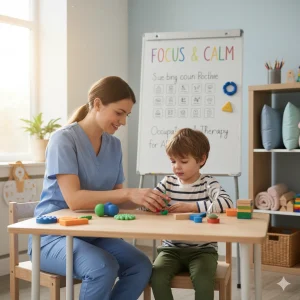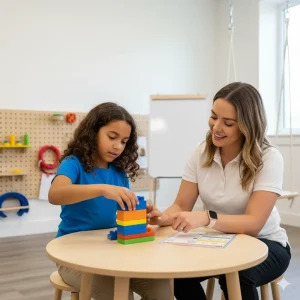How to Speak Fluently: Stuttering Therapy with DAF
By Rajini D
Last Updated: March 6, 2024
Have you ever found yourself stumbling over words, feeling the frustration of not being able to articulate your thoughts smoothly? If so, you’re not alone. Stuttering, a speech disfluency affecting millions worldwide, can be a significant hurdle in daily communication, often impacting one’s confidence and social interactions.
But here’s the good news: the realm of speech therapy is evolving, embracing cutting-edge technologies that offer new hope and solutions. One such innovation that has been making waves is Delayed Auditory Feedback (DAF). This technological marvel has emerged as a beacon of hope for those grappling with stuttering, offering a unique approach to managing speech disfluencies.
Also Read: What is the Relation between Communication, Speech and Language? | Speech and Language Therapy
Decoding DAF Technology in Stuttering Therapy
Understanding DAF: A New Era in Speech Therapy
Delayed Auditory Feedback (DAF) is more than just a technical term; it’s a groundbreaking approach in the world of stuttering therapy. Imagine a device that lets you hear your own voice with a slight delay. That’s DAF for you! This innovative technology plays back your speech to your ears, but with a twist: there’s a short delay. This delay varies, typically ranging between 50 to 70 milliseconds.
Explore our article What is Stuttering: Types, Symptoms, and Causes
How DAF Works: The Science Behind the Technology
The principle behind DAF is fascinatingly simple yet effective. When you speak, the DAF device captures your voice and replays it in your ear after the set delay. This ‘echo’ effect causes most people who stutter to slow down their speech rate, enhancing fluency. It’s like having a conversation with a slight echo of your own voice, guiding you to speak more deliberately.
DAF vs. Traditional Speech Therapy: What Sets It Apart?
Traditional speech therapy often focuses on techniques like breath control, pacing, and articulation exercises. While these methods have their merits, DAF introduces a tech-savvy twist. Unlike conventional methods that rely heavily on therapist-led exercises, DAF offers a unique self-guided experience. It allows individuals to practice and improve their speech fluency independently, using technology as their ally.
Comparing DAF and Traditional Speech Therapy
| Feature | DAF Technology | Traditional Speech Therapy |
|---|---|---|
| Methodology | Utilizes delayed auditory feedback to enhance fluency. | Focuses on breathing techniques, pacing, and articulation. |
| Tools Required | Requires devices or apps that provide auditory feedback. | Often uses minimal equipment, relying on exercises. |
| User Independence | Allows for independent practice with technology. | Typically requires guidance from a speech therapist. |
| Feedback Type | Provides immediate auditory feedback. | Feedback is often provided verbally by the therapist. |
| Typical Results | Can show quick improvements in fluency; varies by individual. | Progress can be gradual, depending on the consistency of therapy. |
Read more about The Speech Chain: Understanding How We Communicate
DAF’s Impact Across Age Groups
DAF: A Versatile Tool for All Ages
One of the most striking aspects of DAF is its versatility across different age groups. Whether it’s a child, a teenager, or an adult, DAF has shown promising results in improving speech fluency.
Also Read: Speech and Language Milestones: 0 to 12 Months
Children and Adolescents: Building Confidence Early On
For children and adolescents, stuttering can be particularly challenging, affecting their confidence and social interactions. DAF technology has been a game-changer here. Studies have shown significant improvement in speech fluency in young individuals using DAF. It’s not just about clearer speech; it’s about nurturing confidence from a young age.
Read more about Navigating Online Speech Therapy for Non-Verbal Children: A Guide for Parents and Educators.
Adults: Transforming Lives
Stuttering in adults can impact professional and personal life. With DAF, many adults have found a new lease on their communicative abilities. Research indicates that a substantial number of adults using DAF experience improved fluency, leading to better job performance and social engagement.
Effectiveness of DAF Across Age Groups
| Age Group | Effectiveness | Key Considerations |
|---|---|---|
| Children | High with guidance | Children using DAF technology typically require close supervision from a parent, guardian, or speech therapist to ensure proper use. Engaging interfaces, such as those found in interactive apps, can help maintain their interest and encourage consistent practice. Customizable settings are beneficial to cater to the specific needs and responsiveness of each child. |
| Adolescents | Moderate to High | Adolescents may show varying degrees of success with DAF, often depending on their commitment and engagement with the therapy. This age group can generally manage the technology more independently, and peer support can be particularly beneficial. Involvement in support groups or forums can provide motivation and shared experiences. It’s also important to consider the social implications and self-consciousness that might affect an adolescent’s willingness to use the device consistently. |
| Adults | Varies individually | The effectiveness of DAF for adults can vary widely based on individual factors such as the severity of stuttering, previous therapy experiences, and personal commitment to the therapy process. Adults often benefit from a comprehensive approach that combines DAF with other speech therapies. This integrative approach can address various aspects of stuttering, including the psychological and emotional components. Regular consultation with speech therapists can optimize the use of DAF and tailor it to the individual’s evolving needs. |
Accessing DAF Technology
Embracing the Future: DAF Devices and Software
In the quest to conquer stuttering, the technological landscape offers a variety of DAF (Delayed Auditory Feedback) devices and software, each designed to cater to individual needs. The innovative application not only provides DAF capabilities but also incorporates a range of stuttering therapy exercises, making it a comprehensive tool for those seeking to improve their speech fluency.
Hardware Options: Tailoring to Your Needs
When it comes to hardware, DAF devices come in various forms to suit different preferences and lifestyles. The single-component DAF device, resembling a hearing aid in design, offers discreetness and convenience, making it a preferred choice for many. On the other hand, multi-component DAF devices consist of an earphone and a control box, which may be connected wirelessly. These devices are versatile, offering a range of adjustments to customize the auditory feedback experience.
Smartphone Apps: DAF at Your Fingertips
In today’s digital age, smartphone apps have revolutionized how we access technology, and DAF is no exception. DAF apps for both iOS and Android platforms offer the convenience of having stuttering therapy tools right in your pocket. These apps typically include features such as voice recording, customizable delay settings, and real-time speech rate indicators. They empower users to practice and improve their speech fluency independently and discreetly.
Integrating DAF in Daily Life
Starting with DAF: Tips and Tricks
Embarking on your journey with DAF technology can be exciting yet daunting. Begin by exploring the delay time settings on your device or app. This feature allows you to adjust how long after you hear your voice. Start with a comfortable delay, typically around 50 to 70 milliseconds, and adjust as you become more accustomed to the feedback.
Practicing in Comfortable Settings
Initially, use your DAF device in low-pressure environments. Practice speaking alone or with a supportive friend or family member. Gradually, as you gain confidence, increase the complexity of your speaking tasks.
DAF in the Real World: Bridging Practice and Reality
Once you’re comfortable with your DAF device, start integrating it into your daily life. Use it during phone calls, in small group settings, or even for public speaking. The goal is to transfer the fluency skills you develop during practice into real-world scenarios.
Inspiring Success Stories
Hearing about others’ success with DAF can be incredibly motivating. For instance, consider John, who has struggled with stuttering since childhood. After incorporating a DAF device into his life, John found that not only did his speech fluency improve, but he also felt more confident in his communication abilities, transforming both his personal and professional life.
Also Read: Speech Therapy at Home: Top Tips For Parents
Navigating the Challenges of Using DAF
Common Hurdles in DAF Usage
Adopting any new technology, including Delayed Auditory Feedback (DAF), comes with its own set of challenges. A common mistake for many new users is setting the delay too long. This can lead to confusion and a disrupted speech pattern rather than the smoother, more fluent speech that DAF aims to achieve. Others might use DAF only in comfortable, low-stress environments, missing out on the benefits it can offer in more challenging speaking situations.
Effective Solutions and Recommendations
To make the most out of DAF, it’s crucial to start with a shorter delay, typically between 50 and 75 milliseconds. This setting can help you adjust to the feedback without overwhelming your auditory processing. Gradually, as you become more comfortable, you can experiment with longer delays if necessary.
Additionally, it’s essential to use DAF in a variety of settings. Start in a comfortable environment, but don’t shy away from using it during more stressful situations, like public speaking or important meetings. This approach will help you generalize the fluency skills you gain to all areas of your life.
Article about overcoming stuttering or speech therapy techniques
Enhancing DAF with Additional Therapies
The Role of Professional Speech Therapy
While DAF technology is a powerful tool, it’s most effective when used in conjunction with professional speech therapy. A speech-language pathologist can provide personalized guidance and support, helping you tailor the use of DAF to your specific needs. They can also monitor your progress and adjust your therapy plan as needed, ensuring you get the most out of your DAF experience.
Combining DAF with Other Techniques
DAF is just one piece of the puzzle in stuttering therapy. It can be beneficial to combine DAF with other techniques, such as Frequency Altered Feedback (FAF) and fluency shaping therapy. FAF changes the pitch of your voice in your ear, providing another layer of auditory stimulation. Fluency shaping therapy, on the other hand, focuses on changing the way you speak to promote fluency. By using these methods together, you can tackle stuttering from multiple angles, leading to more comprehensive and lasting improvements in your speech.
Explore more about Articulation Disorder: A Comprehensive Guide to Clear Speech.
Final Thoughts and Encouragement
The Promise of DAF Technology
As we conclude, let’s revisit the promise of DAF technology. This innovative approach to stuttering therapy represents a significant leap forward in speech fluency and independence. DAF is not just about smoother speech; it’s about regaining confidence and the joy of effortless communication.
Also Read: Prioritizing Mental health: Breaking the chains of Stigma
A Call to Explore and Discover
We encourage you, our readers, to consider DAF as a valuable tool in your journey towards fluent speech. It’s an opportunity to explore the potential of technology in overcoming the challenges of stuttering. Remember, every step you take with DAF is a step towards a more confident and articulate you.
Join Us at Wellness Hub
Interested in learning more about speech therapy solutions? We invite you to dive deeper into the world of stuttering therapy and DAF technology with Wellness Hub. Visit our website at Wellness Hub to discover how we can assist you in finding the right tools and support for your speech therapy journey. Together, let’s unlock the door to clearer, more confident communication.
Conclusion
DAF isn’t just a gadget; it’s a gateway to newfound confidence and smoother communication for those grappling with stuttering. This technology, offering a simple yet effective method of delayed auditory feedback, has shown remarkable success in improving speech fluency across various age groups.
The journey with DAF technology is about embracing innovation to overcome the challenges of stuttering. It’s about harnessing the power of technology to make significant strides in speech therapy. The adaptability of DAF devices and apps allows for a personalized approach to managing stuttering, whether it’s through hardware devices that fit discreetly in your ear or mobile applications that bring therapy to your fingertips.
At Wellness Hub, we’re committed to guiding you through this journey. We believe that everyone deserves the chance to express themselves freely and confidently. Our resources, expertise, and support are geared towards helping you navigate the world of DAF and beyond, towards a future where your voice is heard loud and clear.
Frequently Asked Questions
1. What is Delayed Auditory Feedback (DAF) Technology?
Delayed Auditory Feedback (DAF) technology is an innovative approach in speech therapy that helps people who stutter improve their speech fluency. It involves a device or software that delays the speaker’s voice in their ear by a fraction of a second, encouraging slower, more deliberate speech.
2. How does DAF technology assist in stuttering therapy?
DAF assists in stuttering therapy by altering the way individuals hear their own voice, leading them to slow down their speech rate. This change often results in improved fluency and smoother communication, as it helps in managing speech disfluencies commonly associated with stuttering.
3. Can DAF technology be used for children and adults alike?
Yes, DAF technology is versatile and can be effectively used by both children and adults who stutter. Its adaptability across different age groups makes it a valuable tool in speech therapy for individuals at various stages of life.
4. Are there different types of DAF devices available?
Yes, there are various types of DAF devices available, including single-component devices that resemble hearing aids and multi-component devices comprising earphones and a control box. Additionally, there are smartphone apps that provide DAF functionality, offering convenience and accessibility.
5. What are some common mistakes to avoid when using DAF technology?
Common mistakes include setting the delay time too long, which can disrupt speech patterns, and using DAF only in comfortable, low-stress environments. It’s important to start with a shorter delay and gradually increase it as needed and to use DAF in a variety of speaking situations.
6. Can DAF technology be used in combination with other speech therapy methods?
Absolutely. Combining DAF with other speech therapy methods, such as Frequency Altered Feedback (FAF) and fluency shaping therapy, can enhance overall speech therapy effectiveness. Professional guidance from a speech therapist can help integrate these methods effectively.
7. How can Wellness Hub support individuals exploring DAF solutions?
Wellness Hub offers resources and expert guidance to help individuals explore DAF solutions that suit their needs. From selecting the right device to integrating it into daily life and connecting with professional therapists, Wellness Hub supports individuals on their journey to improved speech fluency.
8. What is the ideal delay time setting in a DAF device for effective speech therapy?
The ideal delay time in a DAF device typically ranges between 50 to 70 milliseconds. However, it’s important to start with a comfortable setting and adjust as needed. The effectiveness can vary from person to person, so experimentation under professional guidance is recommended for optimal results.
9. Can using DAF technology lead to long-term improvement in stuttering?
While DAF technology has shown immediate improvements in speech fluency for many users, its long-term effectiveness can vary. Consistent use, often in conjunction with other speech therapy techniques, can lead to sustained improvements. However, individual experiences may differ based on the nature and severity of stuttering.
10. Are there any side effects or risks associated with using DAF technology for stuttering?
DAF technology is generally considered safe with minimal risks. Some users might initially find the delayed feedback disorienting or distracting, but these feelings usually diminish with regular use. It’s crucial to use DAF as part of a balanced speech therapy program, preferably under the guidance of a qualified speech-language pathologist.
About the Author:
Rajini Darugupally
M.Sc., Speech-Language Pathologist (9+ years of experience)
Rajini is a passionate and dedicated Speech-Language Pathologist with over 9+ years of experience, specializing in both developmental speech and language disorders in children and rehabilitation in adults. Driven by a desire to empower each individual to find their voice, Rajini brings a wealth of experience and a warm, genuine approach to therapy.
Currently, at Wellness Hub, she thrives in a team environment that values innovation, compassion, and achieving results for their clients.
Connect with Rajini to learn more about how she can help you or your loved one find their voice.
Book your Free Consultation Today
Parent/Caregiver Info:
Client’s Details:
* Error Message









